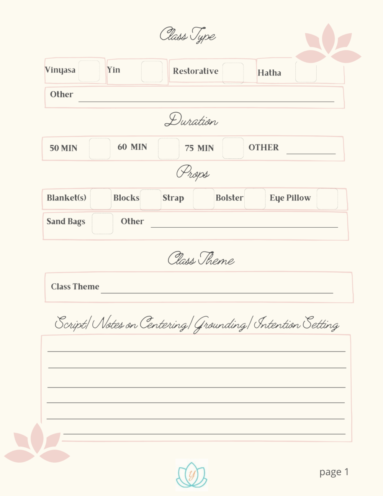For many yoga students, the hour or so they spend in your class is their only – and much needed – reprieve from the daily hustle of their lives. So how do we create a class that will maximize the benefit they receive and keep them coming back for more? How do we guide them to make the most of their practice time?
GROUND AND CENTER STUDENTS
Grounding and centering is where students begin letting go of everything that happened before they arrived in their practice and begin to feel connected to the earth, to the present moment and to themselves. You might guide them through a body scan, asking them to feel the places on their body that are touched and supported by the mat and the earth beneath. You can continue scanning (beginning at the crown of the head or from the feet up) bringing awareness to each part of their body and bringing awareness to gravity pulling them down towards the earth.
In grounding and centering, guide students to bring their awareness inward. This usually begins with focusing on the breath. During the practice we frequently bring students back “to center” to return to a neutral position or bring hands to “heart center.” For more on this and our physical center, Read How to Ground and Center Your Students.
INVITE STUDENTS TO CONNECT TO THEIR BREATH
We all need reminders now and then. That’s all it takes to slow down and reconnect to your breath. Otherwise, we go about our lives shallowly breathing in flight, fight, or freeze mode. Once grounded in their starting posture, guiding students to draw their awareness inward to their breath is a powerful tool. It is here that they arrive in the present moment. It is here that space is created between their thoughts, in their bodies, and in their lives.
Some students may not realize that this is meditation. Meditation is the “uninterrupted flow of concentration,” as defined by the Yoga Journal. Even if just for a few moments, we are teaching students to pause, to redirect their thoughts, to use their breath as an anchor to bring them back to center.
The breath can be used to create space in their physical bodies as well. As students concentrate on the rise and fall of the chest, they can feel how space is created by the breath. You can guide them to feel this space in their bodies as they “lengthen the crown of the head towards the sky on an inhale,” or with a hand on the chest and the belly, feel how each inhale creates space in these areas.
Throughout the class, give students reminders to connect to the breath. Use cues such as, “inhale, exhale,” “breath in, breath out,” “deep breath in, full breath out.”
GIVE STUDENTS SPACE
I know this sounds quite obvious. Of course, they need space for their practice. They roll out their mat and that becomes their physical space. But space is much more than physical. Inviting students to give themselves permission to completely let go of everything that happened before they entered their space is a reminder for them to become present. This begins the process of allowing themselves to pause, to create space in their busy schedule, in their minds, as well as in their bodies, to just be in the here and now.
In the physical space (yoga studio), use proper lighting to set the mood. Be sure the temperature of the room is appropriate for your class. Be mindful of any scents or essential oils you may be tempted to use. Not everyone can tolerate certain scents.
During the practice, remember to allow space and time for students to experience the postures and notice what they are feeling in their bodies. This means pausing your cues, allowing time for quiet introspection, and allowing them to continue mindful breathing through a flow on their own. This may be during a sun salutation, or a cat cow flow, for example. Alternatively, you can pause in a posture and cue them to “stay here for 3 full breaths” or whatever number of breaths you choose.
SERENADE THEM WITH MUSIC
Years ago, when I started teaching, I was so excited to be able to create playlists on Spotify to use in my classes. I eagerly built playlists with familiar music that resonated with me. A lot of it was popular music – the soundtrack to my life if you will. They were familiar songs to most students as well.
Then I realized, if the songs evoked memories in me, they likely did the same for my students. This is NOT something I feel should happen in a yoga class. Creating a sanctuary for students means a refuge from their normal routine. From their thoughts of the past or future. It’s hard to do that if you hear a song that reminds you of a past relationship or worse.
It wasn’t long before I began to shift the way I create my music lists. I now focus more on instrumental, especially in the beginning of class as we become centered, as we wind down, and definitely during Savasana. My playlists now consist of more “yogi music” (East Forest, Trevor Hall, DJ Taz Rashid, DJ Drez, Sol Rising, Jonah Kest) to name a few. Most likely this music has not been a soundtrack to anyone’s life and instead evokes a relaxing mood.
This isn’t to say I never use popular music. If it seems appropriate for a fun themed class on occasion, go for it! If your intention is to create a quiet sanctuary follow the tips above.
GIVE STUDENTS CONTROL
Create a warm and welcoming atmosphere where students feel in control of their own bodies. When grounding and centering, give an option to take a soft gaze if closing eyes is not comfortable. Offer many options, variations, and props. Remind students that they know their bodies best and can opt out of any posture, skip vinyasas, and come to Balansana (Child’s pose) whenever they like. That this is their practice, their body, their time.
When moving into a more challenging posture, give them an option to “stay here” or move into the pose. When giving options, demonstrate the option and perhaps stay in the modified or beginner friendly option.
Furthermore, remind students that everyone is different. All bodies are different, even though we have similar structures, no two bodies are the same. There is no competition in yoga, and there should be no comparison. Even from one day to the next, we can be different ourselves.
CREATE A SAVASANA SANCTUARY
Savasana is the place where you can create the ultimate sanctuary. As the culmination of the practice, you prepare for a period of constructive rest. This is where students will reap the benefits of their practice. Bring them back to center, cue them into breath control, ground them, and offer abundant props.
My motto for Savasana is “there can never be too many blankets!” Invite students to create a headrest with a blanket, to use a blanket to cover themselves, to cradle their arms and legs, and cover their feet.
A bolster can be used for support under the knees, and blocks covered with a folded blanket to support their feet. Use restorative postures, such as Stonehenge, using blocks and a bolster to support legs. See Caren Baginski’s Restorative practice here ending in Stonehenge.
Turn off or dim the lights. Either turn the music off or the volume down. Softly guide them through a body scan, or guided meditation.
Give students the appropriate amount of time for the length of the class – ten percent or more. Allow them to just be in the self-care sanctuary that’s been created for them.
Gently guide them out with a soothing calm voice. Give them time to bring their awareness back to the room, to slowly bring movement back to their body and to come back to a seated position. For more tips read Delivering a Blissful Savasana.
All of these things will help you on your way to creating a sanctuary for your students. Your students will thank you and you will feel rewarded knowing you contributed to their self care. Can you think of other ways to build a sanctuary for your students?





